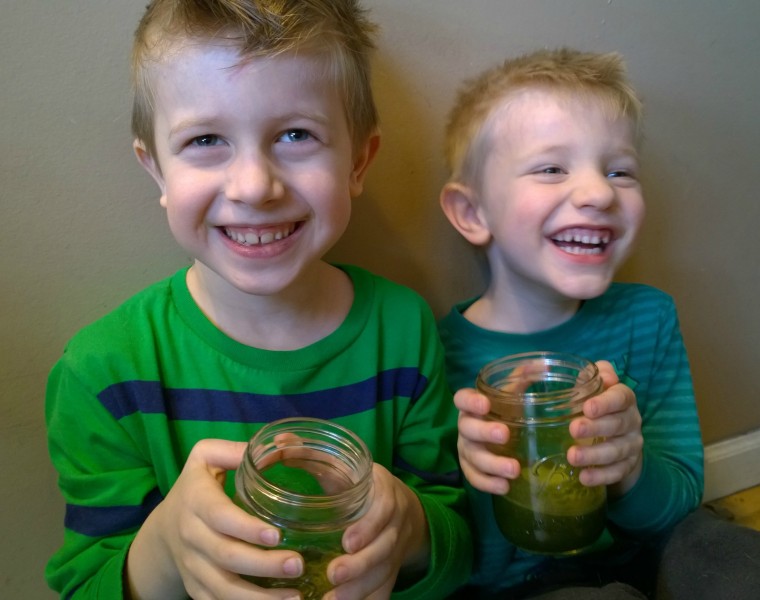Getting kids to eat more fruits and vegetables is one of the oldest parenting challenges. Given the recent green juice and smoothie craze, it’s no wonder parents are turning to blenders for help. After all, what toddler doesn’t love a tasty berry or sweet yogurt concoction that just happens to have some spinach or kale snuck into it?
But experts caution that there is a right and wrong way to “juice” your kids. Not all green drinks are created equal, and some children’s smoothie habits are better than others. So before you grab a bag of carrots and start blending, keep the following in mind.
Don’t give up on actual vegetables
Moms like Sarah LaNore of Monterey, Calif., believe it’s fine to sneak veggies into smoothies. She started doing it when her 18 month-old daughter, Emma, entered the picky eating toddler phase. LaNore, a fitness coach, says they used to call it Emma’s “liquid nutrition” and that the little girl loved her smoothies, despite the secret doses of carrots and kale.
“Blending spinach, carrots, beets and other veggies into fruit smoothies can be a great way for picky eaters to get the nutrients they need,” agrees Bauer. “At the same time, never ever give up on serving them produce.”
There is debate over whether “hiding vegetables” and masking their flavor sets your child up for disliking them in the future. But Bauer believes there’s nothing wrong with adding pureed vegetables into dishes your child already eats or using smoothies — as long as you keep offering the real thing so they can learn what actual broccoli tastes like and so that vegetables don’t seem like the “enemy” in years to come.
“I never hide the veggies in my kids food,” says Rachel Campos-Duffy, a Wausau, Wis., mother of six, ranging in ages 3 to 14. Campos-Duffy describes how, when her kids saw her juicing, they wanted some of the green stuff, too.
“I believe kids are more likely than we think to eat and drink like us if we just don’t succumb to the current trend of ‘dumbing’ down food for them,” says Campos-Duffy, who sees juicing as developing her kids’ palate, not limiting it by “tricking” them into eating something.
Green juices and smoothies have different health values
“Most kids don’t get enough good nutrition from raw, fresh produce in our standard American diet,” says Vanessa Simkins, founder of the Houston, Texas, website All About Juicing. While Simkins is a fan of both juicing and smoothies as essential to a healthy diet, she believes most people don’t realize that there is a “big difference” between the two. Juicing extracts the juice from the fiber. Smoothies, on the other hand, blend whole fruits and vegetables, leaving the fiber intact.
TODAY’s nutrition and health expert Joy Bauer also draws a distinction between the sugars you find in fruit juices and those in whole fruits. While she recommends limiting children’s fruit juice consumption to 8 ounces a day or less, smoothie and whole fruit sugar is packed with plenty of nutrients, water and fiber — and doesn’t present the same health issues that straight juice consumption does.
Beware of teens doing juice cleanses
Aviva Goldfarb of Chevy Chase, Md., recalls how much fun she had with her 16-year old son, Solomon — whom she describes as a picky eater — experimenting with various (and increasingly bold) smoothie blends.
“My son is very athletic but doesn’t naturally eat many fruits or vegetables, but he’s really into high school sports and being healthy and strong,” says Goldfarb, author of “Smooth Start: 10 Healthy Smoothie Recipes.” She realized when Solomon came home from sports — famished — a “power smoothie” was the perfect snack for him and his friends to tide them over until dinner.
Teens, however, should avoid regularly substituting juices or smoothies for meals and they should steer clear of juice cleanses, says pediatrician Dr. Tanya Altmann of Westlake Village, Calif. She reminds parents that adolescents need proper nutrition and a healthy caloric intake not only for their body, but also to concentrate in school, focus while driving and make good decisions.
Smoothies can be hard on kids’ teeth
While green smoothies may be packed with vitamins, fiber and antioxidants, a study published in the British Dental Journal, found that the concentrated sugars in some fruit blends can erode tooth enamel when consumed outside of mealtime.
“The sugar from smoothies sits on the teeth and can produce acid and decay,” agrees Dr. Donald Kohn, a pediatric dentist and former chief of dentistry at Yale New Haven Hospital. “So we generally don’t recommend that they are consumed between meals, as it’s just not practical to expect children to brush their teeth after each one.”
Jacoba Urist is a health and lifestyle reporter in NYC, who drinks a beet and ginger ice smoothie almost every day. Her four-year old son calls it “mama’s gross juice.” Follow her on Twitter @JacobaUrist
